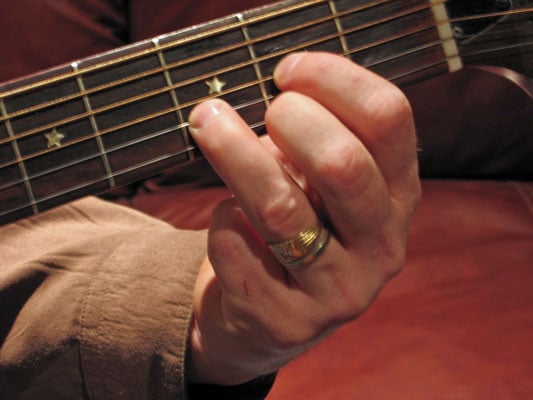Your left hand should fall in place very naturally on the neck of the acoustic guitar. When you play the guitar, your hands should be comfortable and relaxed. If you don't use correct left-hand positioning on the acoustic guitar, your hand can get tense or even cramped. The tension in your hand will reflect in your music and make it harder for you to learn new techniques.
To get an idea of correct left-hand positioning on the acoustic guitar, extend your left hand, palm up, and make a loose fist, placing your thumb roughly between your first and second fingers. All your knuckles should be bent. Your hand should look about like this when it is positioned around the neck of a guitar. The thumb glides along the back of the neck, straighter than if you were making a fist, but not rigid. The finger knuckles stay bent whether they’re fretting or relaxed. Again, the left hand should fall comfortably in place on the neck of an acoustic guitar — like a tool that you’ve been using all your life.
To fret a note, press the tip of your finger down on a string, keeping your knuckles bent. Try to get the fingertip to come down vertically on the string rather than at an angle. This position exerts the greatest pressure on the string and also prevents the sides of the finger from touching adjacent strings — which may cause either buzzing or muting (deadening the string, or preventing it from ringing). Use your thumb from its position underneath the neck to help “squeeze” the fingerboard for a tighter grip.

Left-hand fretting requires strength; because of this, other parts of your body may tense up to compensate. At periodic intervals, make sure that you relax your left shoulder, which has a tendency to rise up as you work on your fretting. Make sure as well that your left elbow doesn’t stick out to the side, like that of some rude dinner guest. You want to keep your upper arm and forearm parallel to the side of your body. Relax your elbow so that it stays at your side.
The important thing to remember in maintaining a good left-hand position is that you need to keep it comfortable and natural. If your hand starts to hurt or ache, stop playing and take a rest. As with any other activity that requires muscular development, resting enables your body to catch up.
Left-hand fretting requires strength, but don’t be tempted to try to speed up the process of strengthening your hands through artificial means. You may see advertisements for hand-strengthening devices and believe that these products may expedite your left-hand endurance. Some of these devices might work, though most do not (and the same goes for the homegrown method of squeezing a tennis ball). However, one thing’s for sure: Nothing helps you build your left-hand fretting strength better or faster than simply playing guitar.

